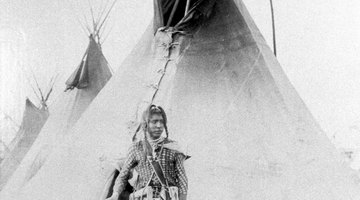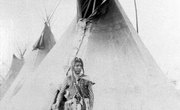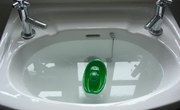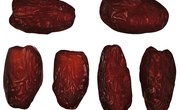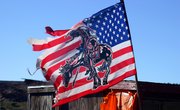The plains Native Americans included many different tribes, including the Sioux, the Blackfoot and the Cheyenne. One of the interesting things about the plains natives were how they built their teepees. Since they were nomadic, they had to be able to quickly put up and take down their shelters. This meant their teepee design had to be functional, yet simple.
Frame
The first step in building a teepee is setting up the frame. Several long poles are needed. According to Shelterpub.com, "These should be straight and smooth, and at least 3 feet longer than the width of the cover." For example, if the teepee is going to be 18 feet wide, the poles should be 21 feet long. Builders arrange three of these poles into a tripod. At the top, where the poles intersect, rope is wrapped around the poles to help secure them in place. Additional poles are added around the tripod. All are tied into place using rope. The last pole has the teepee cover attached, and is placed on the side opposite of the door.
Hide Covering
Hides are sewn together to create a large covering. The hide is attached to the last pole, and then wrapped around the frame of the tepee. The hide is pulled around until it completely covers the frame, which creates the classic cone teepee appearance. The overlapping fabric is sewn or held together with large pins. The bottom of the hide covering is pegged down and the poles inside are moved further out to tighten the covering.
Doorway and Flaps
A flap is left at the bottom and top of the hide covering. This is to provide a doorway and an opening for smoke. A pole is attached to the corner of each flap at the top of the teepee. These poles are pulled open and stuck into the ground to secure them in place. When the fire is put out, the flaps are closed. The flaps at the bottom are left open and act as the doorway. This opening also allows air to flow from the outside, which helps smoke rise and escape through the opening at the top of the teepee.
Decorating
The plains Native Americans often decorated their teepees with pictures of animals and gods and tribal symbols. Each tribe had its own symbol, which was used on their teepees, bodies and weapons. Paint was made from plants and clays. According to CustersLastStand.org, "The pigments were placed over a fire to dry, then ground into a fine powder on mortars of stone or wood. They were then mixed with tallow." The colors were mixed with hot water when the artist was ready to use them. Decorated teepee's symbolized the tribe's beliefs and held deep spiritual meaning to tribe members.
Related Articles
References
Writer Bio
I'm an experienced teacher with a degree in Multidisciplinary Studies-Human Learning. I've worked with various grade levels at different educational facilities. My expertise includes: lesson planning, curriculum development, child development, educational practices and parent involvement.

